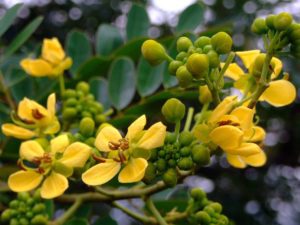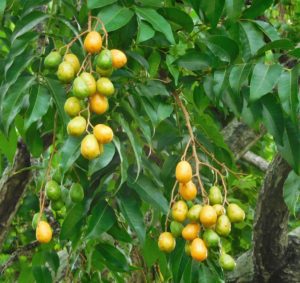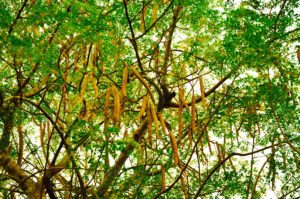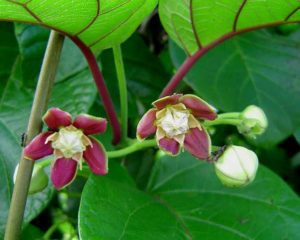Modern medicinal applications are popular among westerners but in Ghana, traditional medicine or herbal medicine including herbalists, spiritual healers, and practitioners are still held in high regard, if not their first choice by default. Traditional medicine can cover herbalism, osteopathy, acupuncture, homeopathy, hydropathy, and other branches of medicinal practices where most involve medicinal plants.
For as long as humans have lived, indigenous traditional medicine (ITM) has been used in the treatment and prevention of common ailments and diseases.1 It is so widespread that according to World Health Organization (WHO), “In Ghana, about 70% of the population depend exclusively on traditional medicine for their health care.” This is due to their cultural and ideological beliefs but also because it is more affordable and accessible than modern day medicine. Some locals need not even consider treatment as their first approach to common ailments is through edible medicinal plants.
What Do These Medicinal Edible Plants Look Like?
To westerners it may look like the new and rising superfoods, but to Ghanaians they’re their everyday foods and herbs but also, their medicine for ailments and diseases. How these herbs or foods are handled depends on their chemical properties and use. Many medicinal plants are readily edible and can be made into tea, salads, or applied directly onto treatable sites. While others, need to be processed and extracted to formulate drug-like concoctions echoing modern medicine today. Some of which are mentioned below where their use and significance are noted.
5 Common Edible Medicinal Plants Found in Ghana
#1: Senna Siamea
 Also known, as Siamese Cassia where its local name is, Abootre. They grow to be up to 60 ft tall and provide wonderful shade because of the tree’s dense foliage. It is part of the bean family Fabaceae, as it produces tender pods and edible seeds. Its leaves are also edible and are known to contain the active compound barakol. It is especially good at removing intestinal worms and preventing seizures in children. The dense inner part of the tree trunk is also used to act as a laxative and even treat scabies. Furthermore, its use in treatment of malaria is prevalent in Ghana, where its phytochemical compounds have been shown to be antimalarial.
Also known, as Siamese Cassia where its local name is, Abootre. They grow to be up to 60 ft tall and provide wonderful shade because of the tree’s dense foliage. It is part of the bean family Fabaceae, as it produces tender pods and edible seeds. Its leaves are also edible and are known to contain the active compound barakol. It is especially good at removing intestinal worms and preventing seizures in children. The dense inner part of the tree trunk is also used to act as a laxative and even treat scabies. Furthermore, its use in treatment of malaria is prevalent in Ghana, where its phytochemical compounds have been shown to be antimalarial.

#2: Psidium Guajava
If this looks familiar to you then you’re probably thinking it’s Guava, and yes, it is. In Ghana, guava is considered to be incredibly valuable and praised for its bountiful health benefits. It is part of the woody family Myrtaceae and once the fruit is ripe it is eaten raw and the leaves are typically consumed in teas. The leaves can be taken by boiling them in water where it can release vitamin C and flavonoids like quercetin that can reduce the risks of cancer, heart disease, asthma, and stroke. Also, the leaves contain anti-inflammatory agents, antibacterial agents, and even tannins that help defend the body from free radicals or oxidative stress. Although, in Ghana they are mostly used to treat measles, diarrhea, and small pox.
 #3: Spondias Mombin
#3: Spondias Mombin
These plants local name is Atoa but it also known as golden apple for their brightly colored fruit. The tree can grow up to 82 feet and has white flowers before it bears fruit. Now, they’re grown for their fruit but also for ornamental reasons. It is part of the cashew family, Anacardiacea where its fruit, leaves, flowers, and bark used for its medicinal benefits. The bark, flowers, and leaves can be made into teas and are used to treat severe cough, hemorrhoids, gonorrhea, convulsion, dysentery, serve as a contraceptive, and even aid mothers facilitate child delivery. Its fruit can be consumed fresh or made into condiments like jellies or even juice.

#4: Moringa Oleifera
Moringa oleifera has many names, some of them being, drumstick tree, miracle tree, horseradish tree, and most importantly has been deemed to be one of the most nutritious plants on Earth. Many parts of the plants can be used including its roots, seeds, leaves, twigs, stalks, and even bark. It was termed miracle tree because of its many vitamins, minerals, and proteins. Approximately one cup of fresh chopped leaves contains, protein, vitamin B6, vitamin C, iron, riboflavin, vitamin A, and even magnesium according to Healthline. This medicinal plant is rich in antioxidants, reduces inflammation, lowers cholesterol, and can help the body defend itself against arsenic toxicity that can be found in contaminated water bodies. This tree is incredibly important in Ghana as it helps local family’s combat malnutrition and achieve food security.

#5: Mondia Whitei
Mondia Whitei, or white’s ginger, is an endangered, perennial, woody and resilient climbing plant that grows from a tuberous root. It a plant that locals recognize to be associated with symbols of peace and power. Its characterized by its pink and white flowers that have fruity yet unpleasant smell. Its leaves are heart shaped and its stems can be woven into ropes making it a versatile plant. Some local valuable medicinal uses of this plant use the roots and leaves to make tea, ginger beer, powder, or mixed into food dishes. It is used to treat general aches and pains, improve sleep, hypertension, enhance urination, ease birth pains, and even allergies. The plant has great nutritional value as it contains the vitamins A, D, K and E, and the minerals, magnesium, zinc, iron, calcium and protein according to the South African National Biodiversity Institute.
How Does This Affect You?
Ultimately, the few plants mentioned above were only the tip of iceberg of valuable medicinal plants but some of them are actually either endangered or threatened. With traditional medicine and at home remedies being local Ghanaians first choice it is imperative we see that these plants recover from their endangered or threatened statuses. We are dependent on biological diversity in ways less visible than the plants and animals we eat and wear.2
If plants are lost, so is biodiversity, and with the loss of biodiversity comes more unpredictable weather, loss of livelihoods, increased contact with diseases, reduced food security, economic costs, and beyond its use is the visibility and cultural value of nature itself. Reducing the exploitation of habitats and plants for subsistence and commercial purposes must be managed and respected. Again, the preservation of all life, animal or plant is key to ensuring a happy and healthy future for all.
IDEAS For US is helping Ghana promote the United Nations Sustainable Development Goal 15: Life on Land, by education, empowering, and helping fund projects like Tree Care and Organic Farm, Building of Wells in rural communities, and Building Sustainable Ghana Initiatives.
Support our Ghana branch at https://ideasforus.networkforgood.com/projects/65411-ideas-for-us-ghana.
Sources:
- https://link.springer.com/chapter/10.1007/978-94-6209-770-4_8
- https://www.nap.edu/read/989/chapter/4#80
- https://chinesemedicine.insightconferences.com/events-list/branches-of-alternative-medicines
- WHO: http://apps.who.int/medicinedocs/en/d/Jh2943e/4.18.html
- http://tropical.theferns.info/viewtropical.php?id=Spondias+mombin
- https://www.treehugger.com/natural-sciences/6-problems-caused-shrinking-biodiversity.html
- http://csir-forig.org.gh/tikfom/database
- http://www.dowhatuloves.com/6-benefits-of-moringa-oleifera/
Photo Credits:
- https://www.flickr.com/photos/33623636@N08/5059269563
- https://www.flickr.com/photos/scotnelson/43692821362
- https://upload.wikimedia.org/wikipedia/commons/9/9a/Spondias_mombin.jpg
- https://upload.wikimedia.org/wikipedia/commons/2/21/The_tree_and_seedpods_of_Moringa_oleifera.JPG
- https://es.wikipedia.org/wiki/Archivo:Mondia_whitei05.jpg
- https://unsplash.com/photos/x8MZ2MoEKLE
- https://commons.wikimedia.org/wiki/File:Plant_a_Sapling_for_Better_Future.jpg








